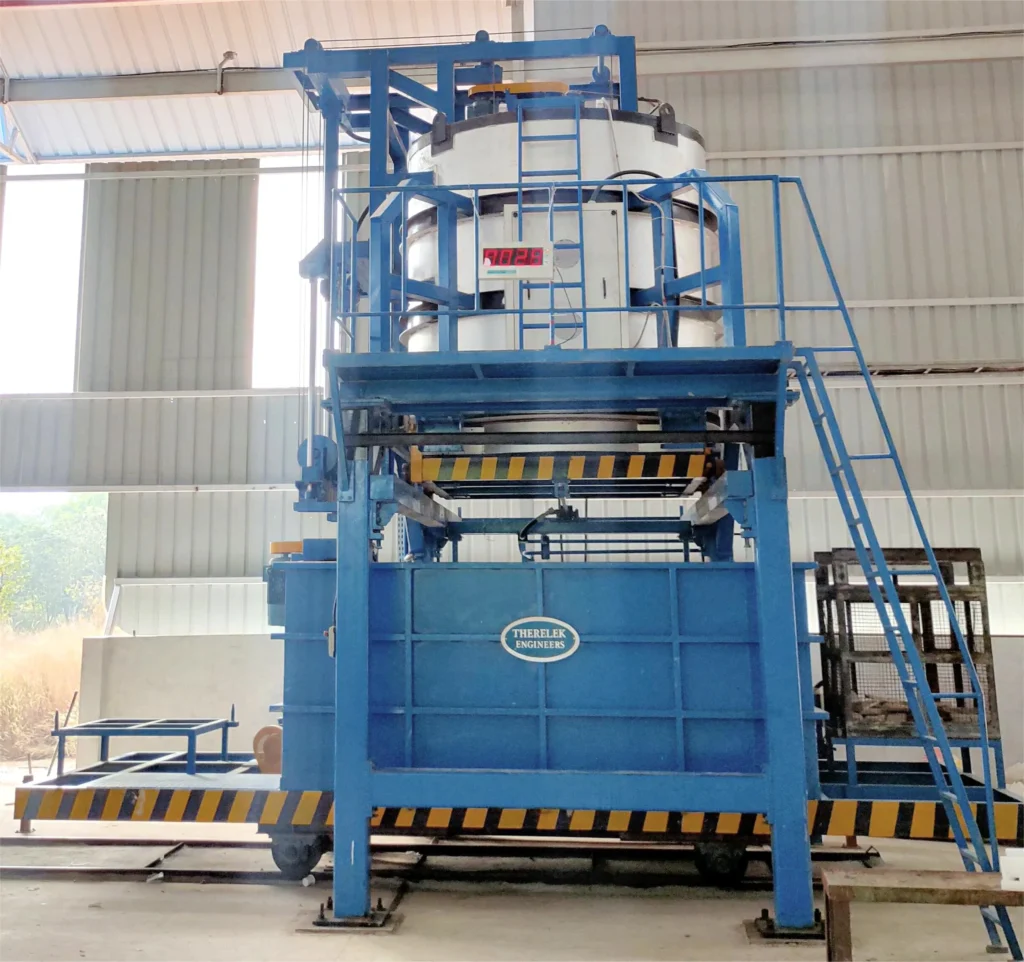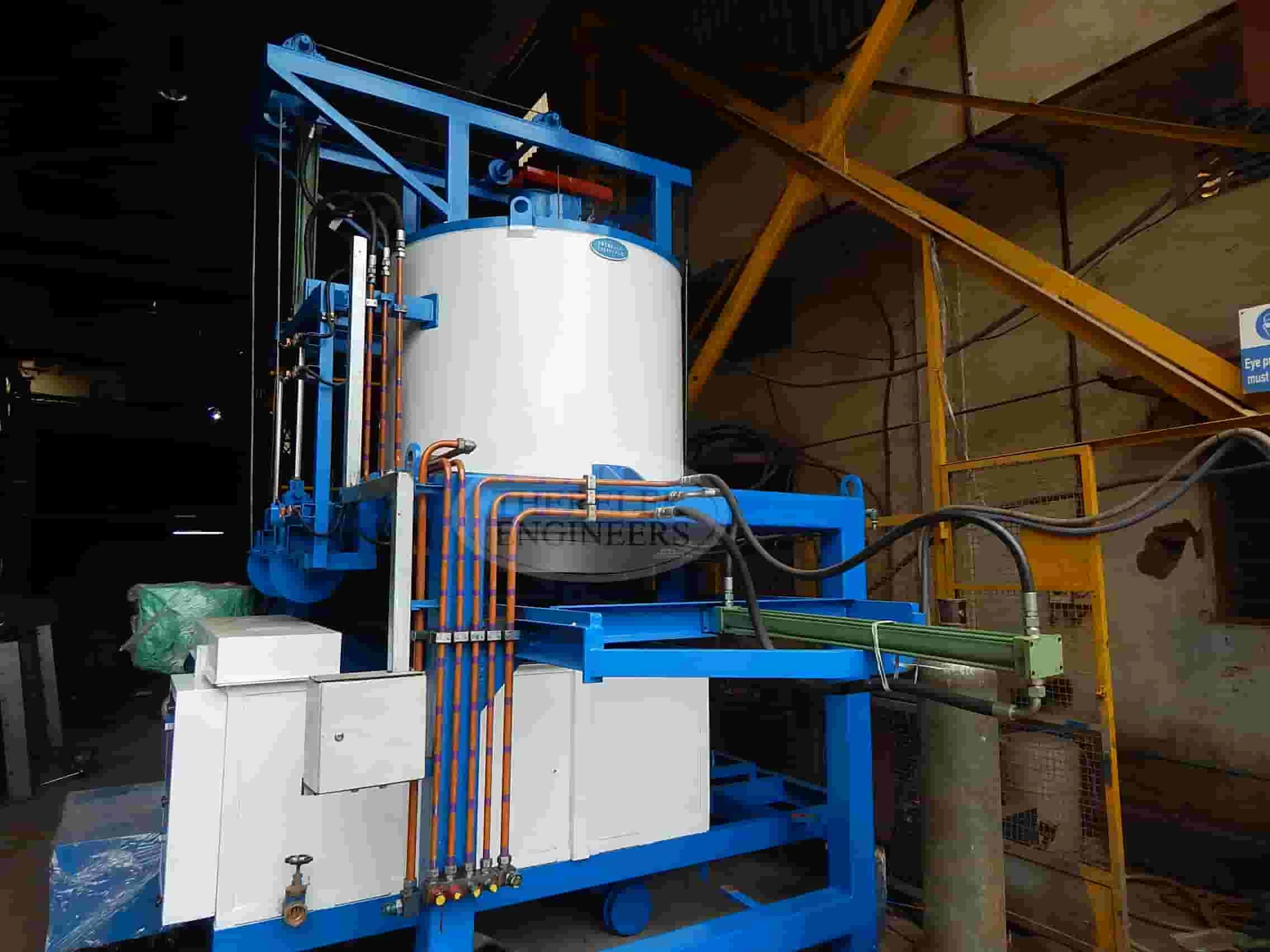Drop Bottom Quench Furnace by Therelek

What is Drop Bottom Quench Furnace?
The Drop Bottom Furnace is the inverted type with charge lifting and lowering facility to accommodate the high-speed quenching including de-clamping, door opening and quenching.
The Drop Bottom Furnace can be a standalone type with charge carrier loader and quenching tank moving on the floor or floor mounted with charge carrier loader and quench tanks sliding in a pit.
As the requirement is very fast quenching, it is fully automated by the use of PLC and SCADA. These furnaces can also be used for continuous ageing cycle ranging from 16 – 24 hrs time.
Where are these furnaces used?
Drop-bottom quench furnaces are used for the solution heat treatment of aluminium alloys. They are designed to operate with tight uniformities from 150°C to 650°C for maximum flexibility to allow for aging and annealing. The drop-bottom furnace stands on a base so that a quench tank can be positioned directly below the furnace.
Because of the broad working temperature range, drop-bottom furnace plants allow complete T6 heat treatments, consisting of solution annealing, quenching, and artificial aging in just one furnace.
Drop bottom furnaces are typically used when very fast water quench times are required. The furnaces are designed to meet all requirements of Aerospace Material Specifications (AMS) AMS 2750E and AMS 2770N, NADCAP, RPS-953 and Boeing Aircraft (BAC) specifications. These furnaces are also used for solutionizing, ageing of structural parts, and in forging industries of aluminium alloys.
Features of Drop Bottom Quench Furnace
- The heavy-duty mechanism for quenching and load lifting.
- This furnace integrates solution heat treatment and quenching into one controllable operation.
- Clamping Door Seal – When closed, the doors are tightly clamped against the bottom of the furnace to prevent cold air leakage which can disrupt the temperature uniformity of the load and increase operating expenses.
- High-Velocity Air – High-pressure blowers provide faster heating rates and tighter temperature uniformity for varying load configurations and densities.
- Recirculating ventilation systems designed to provide large volume and high-velocity airflow through the work zone to ensure uniformity and efficient heat transfer to the load.
- It has a customized air distribution design that matches the airflow pattern requirements according to the product/load arrangement.
- The quench tank can be equipped with controlled heating to pre¬heat the quenching medium and/or a heat exchanger for cooling.
- Water or polymer quench tanks have a single stainless steel wall and have an integrated circulation system of the quenching medium for effective removal of energy from the charge.
Features & Specifications
| TITLE | DESCRIPTION |
|---|---|
| Temperature Range | 500°C to 700°C (for Aluminium Alloys) |
| Standard Applications | Solution Annealing/Solutionizing, Ageing |
| Chamber Design | Cylindrical/Rectangular |
| Insulations | Ceramic Fibre Blanket + Brick/Ceramic Fibre Module & Board |
| Heating Media Options | Electric/Gas Fired/Oil Fired |
| Heating Elements | Nichrome Wire/Special Alloy Resistance Heating Wire |
| Furnace Classification | Class 2 |
| Additional Features | Quench Delay within 7 seconds, Hydraulic Lift & Quench |
| Instrumentation options | Thyristor, Programmable Temperature Controller, Temperature Recorder, PLC, SCADA, HMI |
Temperature Range: 500°C to 700°C (for Aluminium Alloys)
Standard Applications: Solution Annealing/Solutionizing, Ageing
Chamber Design: Cylindrical/Rectangular
Insulations: Ceramic Fibre Blanket + Brick/Ceramic Fibre Module & Board
Heating Media Options: Electric/Gas Fired/Oil Fired
Heating Elements: Nichrome Wire/Special Alloy Resistance Heating Wire
Furnace Classification: Class 2
Additional Features: Quench Delay within 7 seconds, Hydraulic Lift & Quench
Instrumentation options: Thyristor, Programmable Temperature Controller, Temperature Recorder, PLC, SCADA, HMI
Gallery

More about Drop Bottom Quench Furnace
» Solution Annealing/Solutionising
» Ageing
» Homogenizing
» Heavy-duty construction
» Quality components
» High volume airflow provides excellent uniformity and heating rates
» Maintenance-free door gasket & interior
» Meets Aerospace and MIL specifications
» Fully adjusted and factory tested PRIOR to shipment to reduce installation and start-up costs
» Competitively priced
» Custom sizes available
» Aerospace
» Agriculture
» Aluminium Casting
» Automotive
» Forging
» Foundry
» Heat Treating
» Military
» Mining
» Recreational Vehicles
» Meets all Aerospace, MIL & Automotive specifications
» Gas(Direct & Indirect) and electric versions
» NEMA 12 Control Panel (machine-mounted)
» Sliding positive sealing door systems
» PLC/HMI for process automation
» Private labelled and purchased components meet UL, UR, and CE standards.
» 24/7 factory direct technical service and spare parts group.
» Digital PID temperature controller/ programmer
Standard computer interface RS422/232
» Excess temperature controller and additional thermocouples type “K”.
» Standard voltage: 400V; 3ph, 50 Hz or other upon request
» Easy and quick maintenance.
- Applications
- Advantages
- Industries Served
- Advantages
» Solution Annealing/Solutionising
» Ageing
» Homogenizing
» Heavy-duty construction
» Quality components
» High volume airflow provides excellent uniformity and heating rates
» Maintenance-free door gasket & interior
» Meets Aerospace and MIL specifications
» Fully adjusted and factory tested PRIOR to shipment to reduce installation and start-up costs
» Competitively priced
» Custom sizes available
» Aerospace
» Agriculture
» Aluminium Casting
» Automotive
» Forging
» Foundry
» Heat Treating
» Military
» Mining
» Recreational Vehicles
» Meets all Aerospace, MIL & Automotive specifications
» Gas(Direct & Indirect) and electric versions
» NEMA 12 Control Panel (machine-mounted)
» Sliding positive sealing door systems
» PLC/HMI for process automation
» Private labelled and purchased components meet UL, UR, and CE standards.
» 24/7 factory direct technical service and spare parts group.
» Digital PID temperature controller/ programmer
Standard computer interface RS422/232
» Excess temperature controller and additional thermocouples type “K”.
» Standard voltage: 400V; 3ph, 50 Hz or other upon request
» Easy and quick maintenance.
Why Choose Therelek?
Our furnaces are known for their accuracy, durability, reliability, high performance for a long period of time and easy and quick maintenance.
For rapid quenching and uniform convective heating, our fan and duct configurations guarantee close temperature uniformity throughout the load chamber and parts.
The quench delay as per AMS 2770N and AMS 2750E. Call us and see why aerospace, defence & casting companies bring their most stringent application requirements to Therelek for procuring drop bottom furnaces.
FAQs about Drop Bottom Quench Furnace & Process
Solution heat treatment or Solution annealing is carried out for metals like Stainless steel, aluminium, copper, titanium and other nickel based alloys. It is required to dissolve any precipitates present in the material and transform to solution annealing temperature into a single phase structure.
It is required to rapidly quenched down to room temperature to avoid precipitation. After solutionising process the material will be in soft state after treatment.
Hardening can be achieved either by Natural ageing or with a precipitation heat treatment. For few alloys the precipitation takes few days at room temperature, hence it is suggested for artificial ageing at low temperature which provides increased strength and hardness in alloys.
When the furnace door is opened and closed for loading, there is a drop in temperature. It is necessary to recover within the tolerance limit. For parts under 3,2mm thick, the furnace recovery time shall not exceed 30 minutes and for parts made from heavier thickness, it shall not exceed 40 minutes.
